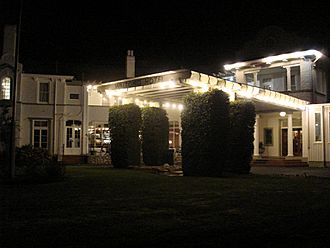Waitomo Caves Hotel facts for kids
Quick facts for kids Waitomo Caves Hotel |
|
|---|---|

Waitomo Hotel
|
|
| Former names | Waitomo House, Government Hostel at Waitomo |
| General information | |
| Type | Hotel |
| Architectural style | Victorian |
| Address | 27D Waitomo Village Road and Access Road, Waitomo Caves |
| Town or city | Waitomo |
| Country | New Zealand |
| Coordinates | 38°15′40″S 175°06′24″E / 38.26103°S 175.10658°E |
| Construction started | 1908 |
| Renovated | 1928 |
The Waitomo Caves Hotel is a famous historic hotel in New Zealand. It was built in 1908 and sits above the amazing Waitomo Caves in the Waitomo District. The hotel is well-known for its special Victorian style. It was first called Waitomo House, then Government Hostel at Waitomo, before getting its current name.
Contents
Hotel History
Early Days
In the late 1800s, more and more tourists started visiting the Waitomo Caves. To help these visitors, an early cave explorer and guide named Tane Tinorau Opataia and his wife built a house in 1901. By 1904, they turned it into a place for tourists to stay, calling it Waitomo House.
In 1905, the New Zealand government bought Waitomo House. It became very popular, so the government decided to build a bigger, more modern hotel. This new building was designed by John Campbell, a well-known architect at the time.
Hotel Gets Bigger
By the mid-1920s, the hotel was too small for all the people who wanted to visit the Waitomo Caves. So, between 1927 and 1928, a large new part was added. This new section is called the "Art Deco Wing".
The extension was designed by the Government Architect John Mair. He used ideas from different styles, like the Spanish Mission style for the thick concrete walls and patios, and the Cape Dutch style for the concrete pillars. This new part looked very different from the older Victorian building.
The extension added a big kitchen, a dining room, and 24 more bedrooms. This meant the hotel could host up to 100 guests!
New Owners and Upgrades
In the 1980s, the hotel's ownership changed. It was given to the Tanetinorau Opatai Trust as part of a special agreement called a Waitangi Treaty settlement.
The trust then leased the hotel to a company that manages hotels. By 2012, the hotel needed a big upgrade, costing about $3.5 million. Many of its 45 rooms were not in good condition. This meant tourists were choosing to stay in other towns instead of Waitomo.
For a while, the trust couldn't get money for the repairs because of a disagreement. But in June 2014, funding for the upgrade finally started. The disagreement was solved in 2015, which meant the trust received money that had been held back for eight years. This helped them fix up the hotel.
A Historic Building
The Waitomo Caves Hotel is very special because it shows the work of two different government architects from different times. It's a great example of their unique building styles. Because of its importance, it was officially registered as a Category 2 Historic Place on June 28, 1990.
Spooky Stories
Many people say the Waitomo Caves Hotel is a very haunted place. Some even call it the most haunted hotel in New Zealand!
- Strange Sightings: People have claimed to see bathtubs dripping blood, glowing orbs floating around outside, and a Māori princess walking through the hallways.
- Chilly Feelings: Guests and staff have reported that the dining room suddenly gets very cold.
- Unusual Sounds: Laughter, the sound of a maid's trolley moving by itself, and even screams have been heard.
- Moving Objects: In some rooms, lights and objects are said to move on their own.
In 2011, a paranormal investigator claimed to have had a "time slip" experience at the hotel. This is when someone feels like they've traveled through time without knowing how. In 2012, a team of ghost hunters investigated the hotel overnight, but they couldn't find clear proof of ghosts.
Hotel on TV and in Movies
The hotel has even been featured on television!
- In 2001, a show called Hauntings on New Zealand's TV2 had an episode about the Waitomo Caves Hotel.
- In 2006, the hotel appeared on Ghost Hunt, another New Zealand TV show.
Famous director Guillermo del Toro said he met a ghost when he stayed at the hotel. He even said the hotel was the biggest inspiration for his 2015 movie, Crimson Peak, which is a gothic horror film.

